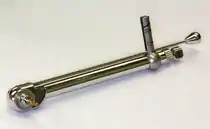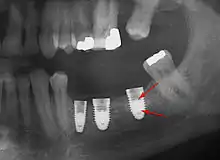


A dental torque wrench or restorative torque wrench is a torque wrench used to precisely apply a specific torque to a fastener bolt for fixation of an abutment, dentures or prosthetics[1] on a dental implant.[2]
Manual mechanical torque wrench
Toggle torque wrenches (friction-style) and beam wrenches (spring-style) are the most common types in dentistry as manual mechanical torque-limiting devices.[3] Beam type wrenches in general are more consistent to its calibration than toggle types. The beam types with a dial indicator are the most precise to set the Tare torque (zero point reset). Because steam sterilization processes like an autoclave are applied to the dental torque wrenches and the length of time in use presents stress on the material, fatigue can occur.[4]
Surgical motor
The surgical motor[5] is an electronic controlled torque-limiting device that also controls the speed. It is used with a twisted drill[6] to make space in the bone for the implant or to fasten the screw (torque control can be with a torque-limiting attachment) with a screwdriver bit.
In high precision areas such as aerospace applications motor or pneumatic torque wrenches are set at a lower torque value after which the final torque is set with a manual mechanical torque wrench, they are calibrated before every use, if a wrench breaks or loses calibration every fastener done with that wrench is redone.
Calibration
Various studies point to deviations of 10% and higher than the desired torque, regular recalibration with a torque tester restores the required torque values.[7]
Re-torquing
As the settling effect[8] (the flattening of the material's micro-surface under pressure) causes a lesser torque of around 10% in a relative short time, re-torquing the fastener after 10 minutes reduces this effect[9] as the parts get more seated.
Wet and dry torque
Wet torques (bolts lubricated with saliva) have a higher mean torque than dry torques (unlubricated).[10]
See also
References
- ↑ Sella, G. C.; Lopes Pereira Neto, A. R.; Maziero Volpato, C. A.; De Vasconcellos, D. K.; Pekkan, G; Ozcan, M (2013). "Influence of different maintenance times of torque application on the removal torque values to loosen the prosthetic abutment screws of external hexagon implants" (PDF). Implant Dentistry. 22 (5): 534–9. doi:10.1097/ID.0b013e31829e548d. PMID 23985429. S2CID 205674898.
- ↑ Kazemi, M; Rohanian, A; Monzavi, A; Nazari, M. S. (2013). "Evaluation of the accuracy and related factors of the mechanical torque-limiting device for dental implants". Journal of Dentistry (Tehran, Iran). 10 (2): 112–8. PMC 3666070. PMID 23724209.
- ↑ McCracken, Michael S.; Mitchell, Lillian; Hegde, Rashmi; Mavalli, Mahendra D. (2010). "Variability of Mechanical Torque-Limiting Devices in Clinical Service at a US Dental School". Journal of Prosthodontics. 19 (1): 20–24. doi:10.1111/j.1532-849X.2009.00524.x. ISSN 1059-941X. PMID 19765196.
- ↑ Mir, Maziar (2012). "The effect of steam sterilization on the accuracy of spring-style mechanical torque devices for dental implants". Clinical, Cosmetic and Investigational Dentistry. 4: 29–35. doi:10.2147/CCIDEN.S32052. ISSN 1179-1357. PMC 3652367. PMID 23674923.
- ↑ Neugebauer, J; Scheer, M; Mischkowski, R. A.; An, S. H.; Karapetian, V. E.; Toutenburg, H; Zoeller, J. E. (2009). "Comparison of torque measurements and clinical handling of various surgical motors". The International Journal of Oral & Maxillofacial Implants. 24 (3): 469–76. PMID 19587869.
- ↑ Nher, H; Lamminger, C; Zimmermann, J; Petzoldt, D (1991). "The value of symptoms and clinical findings in cervical Chlamydia trachomatis infection". Der Hautarzt; Zeitschrift für Dermatologie, Venerologie, und Verwandte Gebiete. 42 (11): 687–91. PMID 1769832.
- ↑ Rajatihaghi H, Ghanbarzadeh J, Daneshsani N, Sahebalam R, Nakhaee M (2013). "The accuracy of various torque wrenches used in dental implant systems". The Journal of Dental Materials and Techniques. 2 (2): 38–44.
- ↑ Winkler, S; Ring, K; Ring, J. D.; Boberick, K. G. (2003). "Implant screw mechanics and the settling effect: Overview". The Journal of Oral Implantology. 29 (5): 242–5. doi:10.1563/1548-1336(2003)029<0242:ISMATS>2.3.CO;2. PMID 14620687.
- ↑ Kim, K. S.; Lim, Y. J.; Kim, M. J.; Kwon, H. B.; Yang, J. H.; Lee, J. B.; Yim, S. H. (2011). "Variation in the total lengths of abutment/implant assemblies generated with a function of applied tightening torque in external and internal implant-abutment connection". Clinical Oral Implants Research. 22 (8): 834–9. doi:10.1111/j.1600-0501.2010.02063.x. PMID 21198900.
- ↑ Nigro, Frederico; Sendyk, Claudio L.; Francischone Jr., Carlos Eduardo; Francischone, Carlos Eduardo (2010). "Removal torque of zirconia abutment screws under dry and wet conditions". Brazilian Dental Journal. 21 (3): 225–228. doi:10.1590/S0103-64402010000300009. ISSN 0103-6440. PMID 21203705.